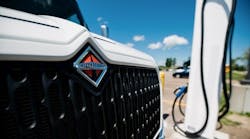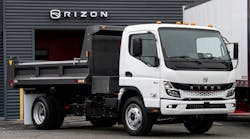FleetOwner queried Derek Rotz, the principal investigator for SuperTruck at Daimler Trucks North America (DTNA) on the technological advancements that led to hitting the targets set for the DTNA-led SuperTruck project a year early, as we reported here.
According to Rotz, the OEM, working with its project partners,the OEM not only reached the finish line far in advance, it actually exceeded the SuperTruck program’s two goals.
The twin-fold upshot is the DTNA SuperTruck program has to date:
- Designed a Class 8 truck that has demonstrated an over 50% improvement in overall freight efficiency vs. a 2007 baseline tractor-trailer combination
- Achieved a more than the 50% gain in brake thermal efficiency required of the engine in each SuperTruck concept vehicle
“The SuperTruck engine target is absolute 50% BTE (brake thermal efficiency), which amounts to nearly a 20% improvement in efficiency over a 2009 baseline,” Rotz explained to FleetOwner.
“Engine targets were achieved by a package of prototype engine technologies integrated to improve overall system performance,” he continued.
Rotz said the prototype technologies resulted in improvements in combustion and air-handling and aftertreatment systems as well as in exhaust heat recovery and the reduction of parasitic [power] losses.
Although DTNA has already surpassed its assigned efficiency marks, the OEM “plans to complete and test a final demonstration vehicle with additional fuel and weight savings measures” by late this year.
Rotz told FleetOwner that to attain those further reductions in fuel use and vehicle weight, the improvements to the final SuperTruck demo will involve:
- Tractor and trailer aerodynamics
- Optimized controls
- Calibration of the engine and exhaust heat recovery
- New predictive technologies
- Active axle-lubrication management
- Lightweight, reinforced ladder-chassis and suspension design
In reply to FleetOwner’s question as to what may comprise the final-year SuperTruck enhancements that Rotz had peviously stated would “not only improve efficiency, but will steer the course for our industry,” he replied that “the SuperTruck program provides DTNA a unique opportunity to push the envelope on developing high-risk/high-reward technologies that may not have otherwise been investigated. These include exhaust heat recovery and hybrid electric powertrains.”
FleetOwner also asked Rotz if any of several new features-- a downsized engine coupled with a hybrid electric powertrain and a waste-heat recovery system-- that DTNA said have already contributed to the project’s success would become available on production truck models.
To which he replied that DTNA “does not comment on specific product plans for the future. However, generally speaking, technologies will spin off into production as they mature and show a positive business case.
“Examples [of that] can be seen today with the aero improvements included on the Cascadia Evolution launched in 2013,” Rotz added, “as well as the powertrain improvements in the launch earlier this year of the integrated Detroit powertrain package.”
Sponsored by the Department of Energy (DOE), the SuperTruck program is an expansive five-year R&D initiative focused on improving the freight efficiency and reducing the fuel consumption as well as the greenhouse-gas (GHG) emissions of Class 8 trucks. Including DTNA, four major truck OEMs were awarded multi-million dollar grants by the DOE to participate in the program
![... 'generally speaking, technologies will spin off into production as they mature and show a positive business case. Examples can be seen today with the aero improvements [developed for the SuperTruck project] included on the Freightliner Cascadia Evolution.' --Derek Rotz, DTNA's principal investigator for SuperTruck ... 'generally speaking, technologies will spin off into production as they mature and show a positive business case. Examples can be seen today with the aero improvements [developed for the SuperTruck project] included on the Freightliner Cascadia Evolution.' --Derek Rotz, DTNA's principal investigator for SuperTruck](https://img.fleetowner.com/files/base/ebm/fleetowner/image/2019/04/fleetowner_4231_freightlinercascadiaevolution4fleetowner.png?auto=format,compress&fit=crop&q=45&h=139&height=139&w=250&width=250)


